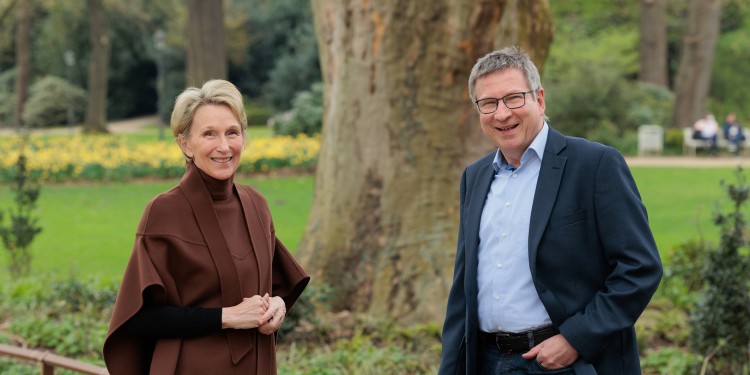
EU Research Council awards "Advanced Grant" to Lydia Sorokin and Christian Weinheimer
Biochemist Prof. Lydia Sorokin and particle physicist Prof. Christian Weinheimer from the University of Münster have each received one of the coveted Advanced Grants awarded by the European Research Council (ERC). The grants, together totalling almost six million euros, enable the recipients to realise outstanding research projects. “The grants are not only in recognition of the researchers’ achievements but also clear evidence of the top-level research being carried out at the University of Münster,” says Rector Prof. Johannes Wessels. “However, such top-level research is not possible without talented junior researchers. The funding helps young scientists to actively shape this research and push it forward, for example, by financing PhD students and post-docs aiming at an academic career.”
Lydia Sorokin heads the Institute of Physiological Chemistry and Pathobiochemistry at the Faculty of Medicine. She studies extracellular matrix (ECM) of blood vessels, in particular blood vessels of the brain. These vessels are particularly impermeable for cells, toxins and pathogens and together with their ECM constitute the blood-brain barrier (BBB). One of the main working models in Lydia Sorokin’s lab deals with multiple sclerosis and how leukocytes (“white blood corpuscles”) migrate across the BBB into the brain to induce disease symptoms. The focus in the ERC project is on the particular space – discovered by the Sorokin team – that is unique for cerebral blood vessels and is formed by two specialized ECM structures that constitute the borders of the perivascular space. This site harbours genetically distinct resident leukocyte populations, the function of which are unknown. In addition, it is a preferred location for leukocytes before they penetrate the brain in inflammatory diseases of the brain. The aim of the project – financed by the ERC Grant – is to study the molecular processes that are not only essential for maintaining the BBB, but which also make it possible for the immune cells to penetrate this barrier. To this end, Lydia Sorokin and her team aim to create three-dimensional simulations of the essential components of the BBB in vitro (in the laboratory) including the perivascular space. In combination with studies involving genetically modified mice, the researchers want to find out how, in the case of inflammatory diseases, the leukocytes manage to penetrate into the brain. Simulating the BBB in the lab will in the future open possibilities for screening of drug transport into the brain to combat inflammation or even tumours in the brain.
Christian Weinheimer, director of the Institute of Nuclear Physics, is involved with his team in the Department of Physics in research on two large-scale international projects which represent two of the greatest puzzles in physics: the determination of neutrino mass, and the search for dark matter. Weinheimer and his group are not only involved in the measurements and in data analysis, the Münster team are also internationally renowned for developing essential components that enable the sensitive measurements to be carried out. In the search for dark matter involving the XENONnT experiment – which is located underground in the Gran Sasso National Laboratory (LNGS) below the Gran Sasso mountain range in Abruzzo, in Italy – scientists are searching for so-called “WIMPs” (weakly interacting massive particles). These particles, although still hypothetical, are very promising candidates for what may constitute dark matter. The international XENON collaboration investigates collisions between WIMPs and atoms of the noble gas xenon. To make these measurements possible, the Münster team have developed special equipment which removes disturbing traces of radioactive isotopes of the noble gases crypton and radon. Now, for the planned follow-up experiments in “DARWING/G3” supported by the ERC Advanced Grant, the team aims at significantly improving the reduction of contaminants in the noble gas isotopes and, at the same time, developing new diagnostic methods for detecting any remaining, extremely small traces of radioactive isotopes in the noble gases. The planned research also includes work in the field of neutrino physics.
The "ERC Advanced Grants" are aimed at established researchers who in the past ten years have demonstrated outstanding scientific achievements. Other funding lines are, for example, ERC Starting Grants" and "ERC Consolidator Grants" which target earlier career stages. Overall, there are around 25 researchers at the University of Münster who have received an ERC Grant in the course of their career.
